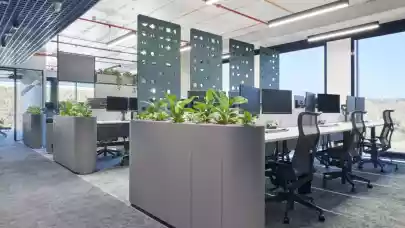
Offices might become hotels, hotels can be converted into apartment buildings and warehouses may serve as retail centres. But location, revenue-generating capacity and environmental considerations are the most important factors in converting successfully an existing commercial property, say experts of Hungarian developer Wing. Ernő Takács, Deputy CEO, responsible for hotels and retail at Wing and Chairman of the Association of Hungarian Property Developers and Gábor Angel, Deputy CEO, responsible for offices at Wing, talked to Property Forum about the challenges of changing the use of a property.
Changing the function of an existing building is always full of challenges. What makes a developer start such a project instead of investing in a completely new building?
GA: Such decisions are influenced by several factors, including the costs and the time required for the development, but the two key factors when remodelling an existing building are, firstly location (in Budapest and other large cities, the greatest locations are already built in, so you must do something with the existing buildings if you don’t want to demolish them) and, secondly environmental considerations, which includes not only energy issues but the reuse of structures that have already required a lot of invested resources and energy.
Why would we pull down a suitable structure that can be utilized and then build it back with almost the same parameters, with a considerable environmental load when we could use the original structure? For example, Gizella LOFT, in HOP, has been redeveloped with this approach based on circularity and sustainability. By not choosing to demolish an existing building and then build a completely new one, we spared significant damage of CO2 emissions which equals the oxygen production of almost 1000 trees over a century. Another example would be WING’s headquarters, Máriássy House, the former Calf Market Hall converted into an “A” category loft office building.
ET: There is a third factor when the function of a building is changed: its revenue-generating capacity and, as a result, the value of the property increases considerably. This is what we saw at the Agria Park shopping centre, which is the redevelopment of the former tobacco factory in the city of Eger, and at the B&B Hotel Budapest City Hotel, where an office building was converted into a 3-star hotel.

Ernő Takács
Deputy CEO
WING Zrt., IFK Chairman
What are the most important factors to consider when it comes to the feasibility of a given plan? Technical issues? Commercial use? Size of the investment?
GA: You never know in advance which factor will be the most important. All the factors combined must lead to a solution that is comparable to a new development. The factors may have different weights in different projects. The redevelopment of a 100-year-old downtown building is different from the change of function of a 30-40-year-old building.
ET: I believe, the most important factor is the increase in the value of the property as a result of the change in function alongside ESG considerations. We have two such completed projects and another one in the construction phase, all in Budapest.
What were the most difficult moments when realising these projects?
ET: Our company has been a pioneer as we were the first to complete green conversion and green retrofit projects, and we are currently considering and preparing several similar developments. In our experience, what can be difficult, in addition to modernising outdated structures and developing a fitting floor plan that is ideal for the new function, is ensuring compliance with current construction standards and regulations (fire prevention, energy efficiency, in certain cases heritage protection, etc.).
GA: Another challenge with such projects is the covered structures we find in these buildings during the construction phase. Of course, in the planning and preparation phase, we need to perform the most throughout inspections to get the exact parameters of any covered structures, but still, during the actual demolishing and construction, we almost always detect deviations and features that even the most thorough planning couldn’t predict and we need to adapt to these in the construction phase.
From our ongoing projects, I would like to highlight Liget Center, which will be completed in Q2 next year and will be the headquarters of RTL Hungary. While it is a BTS project, both existing properties are protected heritage buildings. It is not simply a renovation; the iconic buildings must be adapted to the new, complex office function while keeping as many authentic details as possible.

Gábor Angel
Deputy CEO, Office
Wing Zrt.
Do you agree that underperforming class B and C office buildings in relatively good locations may be on the radar of certain developers aiming to convert those properties into hotels, residential complexes or student houses?
GA: The office market is constantly evolving and, as a result, buildings in certain locations and with certain features no longer meet the tenants’ requirements. In such cases, changing the function of the building could be a good solution.
ET: Absolutely, for a complex property developer with expertise and experience like Wing, this is a great opportunity.
In Prague, former apartment buildings, converted into offices in the 1990s are now back in the residential market. Is there any chance to see such reuse in other parts of CEE including Hungary?
GA: The situation of certain property segments and the relative value of locations change and, as a result, although slowly, the functions of the properties can also change. Nowadays having a downtown apartment is popular again; people buy these to live there or to rent them out. The value of such centrally located apartments has multiplied in recent years. At the same time, the preferences of tenants in office buildings have changed, and while the location is important, they aren’t necessarily looking for central locations that are not easily accessible by car and have no parking garage. Since the pandemic, tenant requirements have been redefined, and now we see a need for flexible use of space.
Hundred-year-old buildings in the city centre cannot easily meet these new expectations, unlike modern, open-space offices that tenants can freely adapt to their needs. This has resulted in the relative devaluation of centrally located office buildings as compared to, for example, residential projects. So, the trend I mentioned may emerge in the Hungarian market and in other CEE countries, too.
We see several new retail outlets and residential units in converted industrial properties in Budapest. Do you expect more supermarkets, warehouse centres, retail outlets and residential units to come as the government extends the number of special brownfield zones that allow developers to use lower VAT in sales?
ET: The reduced VAT rate of so-called brownfield zones is only applicable to new residential developments. However, this means there will be a considerable number of residential projects at these great locations in the future, which will create the opportunity for the development of retail properties of various sizes. It is another question whether there will be enough expertise and development capacity to exploit these opportunities: companies also have to be able to obtain one or more so-called shopping centre permits.



